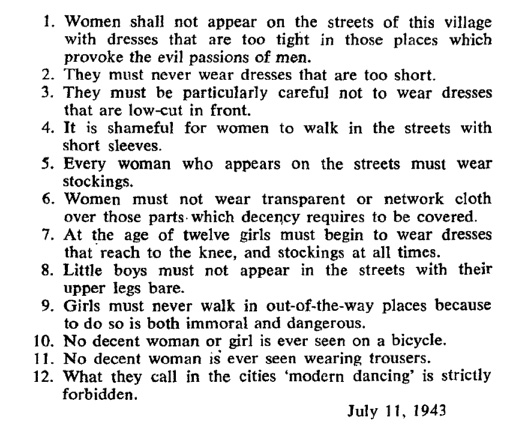I don't know who had the idea, but an impressively daft move in the history of feminist thought was to take Marx's view that history is a series of struggles between ruling and opressed classes and declare that Marx's scheme was much too complicated and that all of history may be seen as men's war on women. It's very parsimonious, but it also provides a bad match to the evidence. A much better idea out of feminism (which is, after all, a heterogenous body of thought): What we see a lot in history is that men regard women much like children: they do love them, alright, but they also think that they can't be taken all that seriously and hence have no place in science, politics, etc.
The central idea of intellectual conservatism is this: Traditions are not just random rules; instead, tradition hands down those rules that have stood the test of time. This is why we should be careful about messing with those rules, even if we don't understand what they're good for.
Feminist and conservative thought are usually seen as opposites, and not without good reason, but I think you might need both when explaining the contents of the gem shown below, brought to us by Maria Popova, who explains that it is
a poster James Michener makes note of in Iberia, which he encounters pinned to a church door while traveling across rural Spain in the late 1960s. Dated July 11, 1943, [it was] laid out by a bishop as a code of conduct for local life
Here's what appears to be a reproduction from Michener's book:
There's nothing wrong with taking this as an opportunity to lament the "matter-of-factly subjugation of women", as does Popova, but that normative statement naturally doesn't help us understand why such rules exist (an analytical question).
To answer it, we might want to imagine what normative statement a conservative might make in reaction to these rules. It might go something like this:
When you look at the rules, you'll see that most of them boil down to "women shouldn't present themselves as overly sexually attractive" (no.s 1-7, and perhaps 10 and 12, too). Another rule tells them to avoid dangerous places. The very first rule spells out why these rules exist: "the evil passions of men." In other words, these are rape avoidance rules, and good ones, too. They are a good example of the wisdom of the ages being handed down to us. It's all right to dispense with them - if you're willing to accept an increase in rape rates.
Our hypothetical conservative assumes that sex is a rape motivation. Though disputed by some feminists, this view is almost certainly correct. While evidence exists to support it, perhaps the most convincing argument for the claim is theoretical. Writes Steven Pinker (The Blank Slate, p. 362):
First obvious fact: Men often want to have sex with women who don't want to have sex with them. [...] Second obvious fact: Some men use violence to get what they want, indifferent to the suffering they cause. [...] It would be an extraordinary fact, contradicting everything else we know about people, if some men didn't use violence to get sex.
So, we might be prepared to accept that covering one's cleavage and avoiding the more dangerous parts of town reduces the likelihood of a woman getting raped. But why, then, would they have to be rules, instead of just pieces of advice? This is where the women-as-children view comes in: Obviously, you can't trust women to choose to do the right thing, so just force them. Which wasn't that much of a problem, given the power differentials in traditional societies.
It would be easy to say that these days we are much more enlightened, but that's not so obvious. On the one hand, grown women are now allowed to make their own choices about how much risk to take. On the other, feminism - which did much to put the topic of rape on the agenda, make rape in marriage illegal, and the like - came with the fanciful theory that rape is not about sex, which reduces women's ability to make well-informed choices about how much of a rape risk to take.
Just in case, I should perhaps point out that providing a causal explanation is not the same as apportioning blame. In fact, much misunderstanding stems from the idea that an undesirable event comes with a fixed amount of blame to be apportioned, so that apportioning some of the blame to one person automatically reduces the amount of blame left for others. More importantly, though, if you take a high risk of victimization, that doesn't mean you give others the right to harm you. Comments which appear to be based on a failure to read this paragraph will be deleted.

No comments:
Post a Comment